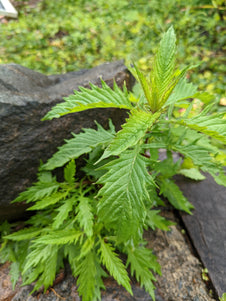



Gypsywort
Gypsywort

- Low stock - 20 items left
- Inventory on the way

Usually available: August to April
Life cycle: Perennial
Height: 20 - 80cm
Position: Sun / part shade
Soil preference: Moist
This is how we pack and send your Herb Plants to all states except TAS & WA
You will receive
- 1 Gypsywort Herb Plant in a 50 X 75mm tube - General growing instructions
All of our Herb Plants are grown organically with certified organic potting mixes and fertilizers
Botanical Name: Lycopus Europaeus
Gypsywort is a perennial with a spreading habit, reaching from 20-80cm in height. It has quite a straggly appearance, but can form quite large, matting clumps which look a little tidier. The green and hairy leaves are narrow, lanceolate, with a toothed margin that creates a sharp look to the leaves. The floral inflorescence is held on a terminal spike made up of dense whorls of white-pink, tubular and lipped flowers. It flowers in summer, with seeds appearing a few months later.
Gypsywort is native to Europe and Asia, but is naturalised in some regions including the USA. Its natural habitat is around water, such as marshes, lakes and river edges. The botanical designation for this plant is Lycopus europaeus from the Lamiaceae family. Gypsywort may also be known by names such as Common Buglewood, Water Horehound or European Buglewood. Its most widely used name, ‘Gypsywort’, is derived from the habit of Gypsies who used it to dye their clothes and/or skin. Today, black dye is still produced from this plant on an industrial level.
Growing Conditions
Gypsywort grows in sunny or lightly shaded positions, with a preference for damp and even boggy soils. In the home garden a regular supply of water will yield the best results. In a natural situation it will tend to grow near water sources or marshy areas. It spreads both by seed and rhizomes so carpets of the plant can sometimes grow larger carpets which float on water surfaces. This enhances their survival and allows new populations to establish in a different location.
Culinary Uses
Gypsywort does not have any known culinary uses.
Medicinal Uses
Gypsywort contains a number of useful active constituents that combine to assist with several medical conditions when used in therapeutic doses. It contains flavonoids, tannins, phenolic acid derivatives such as rosmarinic acid, a bitter essential oil and manganese, fluoride and other elements. The active components affect uric acid metabolism and so are helpful for treating gout and they modulate hormonal responses, such as those involved in the menstrual cycle and blood sugar regulation. The most useful action, however, is the effect of gypsywort on iodine metabolism and on the hormone thyroxine to the extent it can help with treatment of hyper or overactive thyroid. In the past it has also been used as an astringent and as a sedative. As a result, gypsywort should be avoided by those suffering sluggish or hypo-thyroid. It should also be avoided by pregnant and breastfeeding women.
All information provided on this website is for informational purposes only. Please seek professional advice before commencing any treatment.






